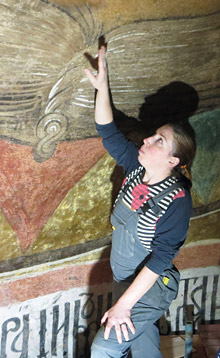
Electronic english version since 2022 |
The newspaper was founded in November 1957
| |
Youth and science
Look into the depths of time under the dome of the cathedral
Part one. Moscow. Kremlin
The restoration of the frescoes of the Assumption Cathedral of the Moscow Kremlin was started in 2017 and currently, the work is underway. A trip to the Assumption Cathedral allowed me to learn about the work "in the field" of the staff of the group of Neutron Activation Analysis of FLNP, to immerse myself in the subtleties of restoration and the features of this historical monument unknown to an average visitor.
"We are engaged in the investigation of wall painting," an employee of the group N.V.Glombotskaya says on the way to Moscow. "We determine the elemental and mineral composition of paints, we can say what kind of binder was used. We have a portable device for non-destructive X-ray fluorescence analysis (XRF) that we apply to the wall with paintings and get the elemental composition of the fresco. So, we can quickly tell what kind of paint was used, such as for instance, red can be based on cinnabar or ocher. Specialists in the Assumption Cathedral had questions and one of them was about the determination of the age of the gilding. Using our XRF device, we will be able to determine which century it belongs to by comparing it with known samples of gilding from different centuries. This is indirect, preliminary dating. And if the restorers give us pieces of frescoes to the laboratory, we will be able to carry out a more detailed research. For example, using stratigraphy, one can see how many and which layers there are in a sample. Polarizing microscopy allows to distinguish pigments by their optical properties. And infrared spectroscopy helps to establish the type of binder.
In the Assumption Cathedral after measuring the spectrum with an XRF device, Natalya Glombotskaya announced to the restorers the percentage of some elements. The results of express analysis were estimated by restorers. Sometimes their result influences the choice of the next point of analysis. Already in the laboratory, Natalia will carry out further research using additional techniques, she will use microscopes, make microchemical analysis and stratigraphy that are long weeks of work.

Art historian Olga Zakharova and FLNP employee Natalia Glombotskaya
"We study the wall painting of 1643 in the Assumption Cathedral of the Moscow Kremlin," senior researcher at the Moscow Kremlin museums O.A.Zakharova says by explaining the progress of work in the cathedral. "The fact is that the process of creation and the materials from which this mural was created is an extremely documented history. Old Russian art reaches the time of Peter the Great. For this long, almost 700-year period, it is rare when there is a monument and a document about the monument at the same time. And for the XVII century, such cases appear. And we decided to check which of those materials that we know about from documents that they were purchased in 1643 by decree of Tsar Mikhail Fedorovich Romanov, we can find here. We have a list of paints, we understand that they were most often used in mixtures, however, understanding the composition of the mixtures that form the paint surface and their relationship with the purchased materials, verification of documents is a scientific task. Our painting has suffered significant losses and we currently strive to work only with those sections of this huge ensemble of 1643, there are not very many of them that have come down to our time in a more or less intact form.
 |
| The restorer Alexandra Grebenshchikova is chosing a point for analysis |
(To be concluded)
Olga TARANTINA, photo by the author